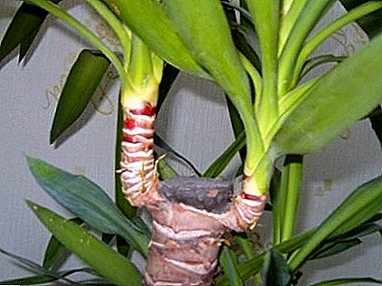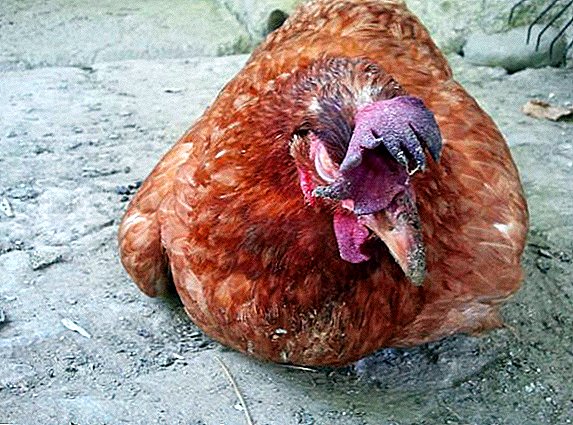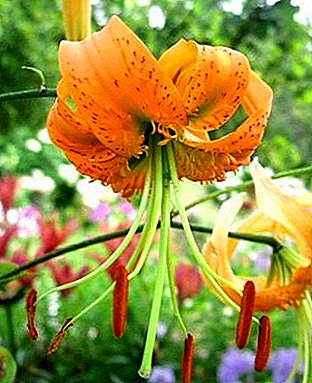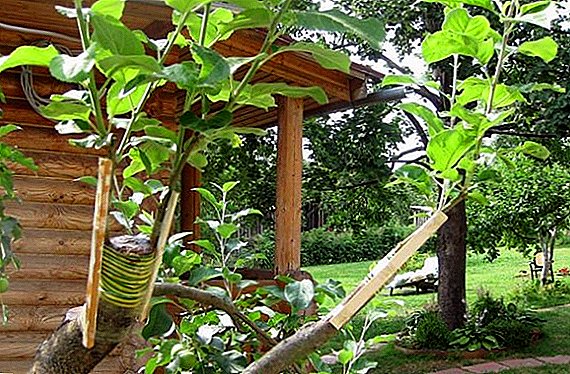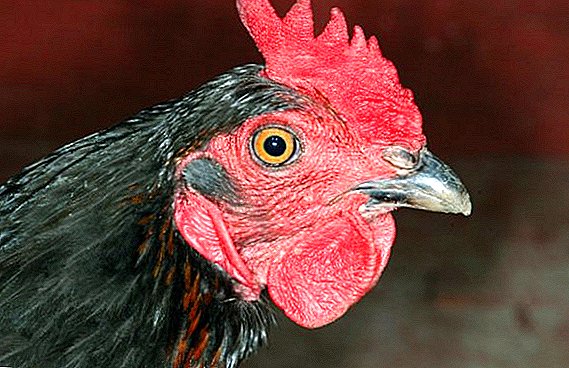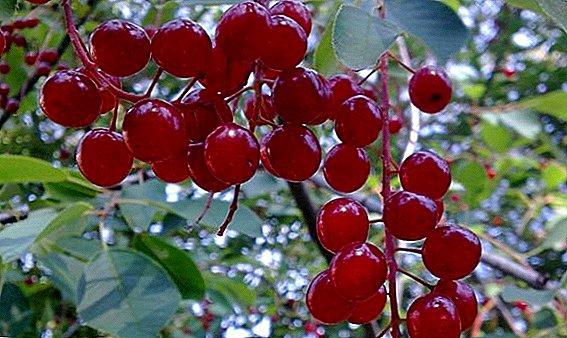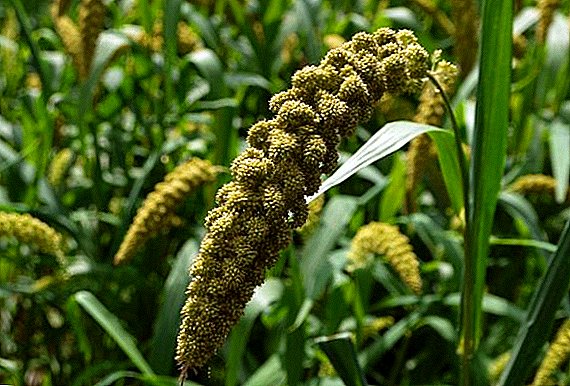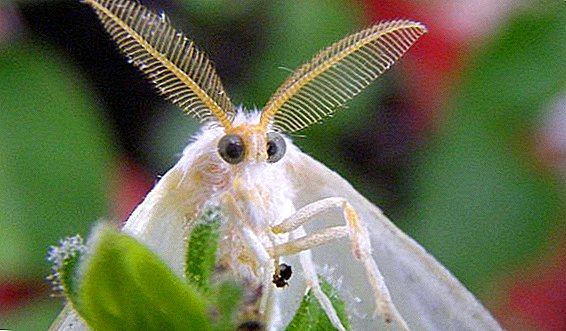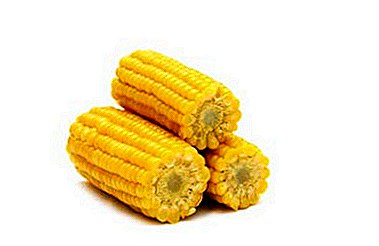 Sooner or later, any summer resident - a gardener-gardener-grower - is confronted with such a scourge as pests that destroy planted plants with love.
Sooner or later, any summer resident - a gardener-gardener-grower - is confronted with such a scourge as pests that destroy planted plants with love.
What kind of pests threaten gardens and vegetable gardens, and how to deal with them - let's look at this article.
White fly
The whitefly is a miniature butterfly of a whitish color, more like a mole, its body length does not exceed 3 mm. 
Butterfly species:
- citrus;
- greenhouse or hothouse;
- cotton;
- tobacco;
- cabbage;
- strawberry.
The butterfly, settling on plants, leaves on them numerous voracious offspring, which sucks out all the juices and nutrients from the green part. To discover it, it is enough to shake the bush - and a white cloud will rise into the air.
Eggs and larvae are on the inside of the leaves. As a result of their residence, small yellow dots remain on the leaf, traces of punctures for the extraction of juice. An adult may be a carrier of viral infections; her offspring, leaving on the foliage the products of their vital activity, gives food to fungi. 
You can fight insects by spraying infected cultures with chemicals:
- Iskra-M;
- "Malathion";
- "Tsiktor".
In the contaminated greenhouse you can hang the usual sticky traps or fumigators from insects.
Folk remedies can also be effective.
Usually carry out several spraying infusions of plants:
- garlic;
- dandelions;
- tobacco leaves.
Fleas
Pest bugs are called for small sizes (up to 4 mm in length) and jumping ability, but according to the description of entomologists these are bugs. Depending on the species, they are black, light brown, green with a metallic sheen, and black with a blue sheen; some have yellow elytra. 
Types of garden fleas:
- cruciferous;
- rapeseed;
- beet.
Learn how to deal with cruciferous flea, as well as how to deal with it on radishes and cabbage.
They feed on foliage, stems, heads, or root crops. Over time, fleas can turn a leaf into an openwork sieve. The larvae of bugs destroy young seedlings of crops.
With the timely detection of parasites, in the fight against them enough popular methods:
- spraying the infusion of the tops of tomatoes with the addition of grated soap;
- processing infusion of flowers and dandelion roots;
- pollination with wood ash and tobacco powder.
With a large accumulation and the presence of numerous offspring, infected landings are treated with Carbofos. 
Exclamation scoop
Insect is a type of scoop scoop, one of the most dangerous, because it does not distinguish between cultures. It eats everything - foliage, stems, fruits, and even root vegetables.
It is a moth with a wingspan of up to 4 cm, gray-brown color, got its name for the spot in the form of an exclamation mark on the wings. Its caterpillars are dark gray, about 3 cm long.
Preventing the appearance of shovels, when digging before sowing, granulated insecticides are introduced into the soil.
To insecticides include drugs such as "Enzio", "Marshal", "On the spot", "Fastak", "Lightning", "Calypso", "Kinmiks", "Vertimek".
To combat it, use these drugs:
- "Agrovertin";
- "Natur Gard";
- "Fitoverm".

The people used decoctions of such plants:
- tomatoes (foliage);
- mustard (powder);
- wormwood (with wood ash and soap).
Also for adults, sweet traps are set: small containers filled with water with the addition of jam or sugar.
Did you know? In large agricultural farms for the destruction of eggs scoop on the field produce another insect - trichogram, which parasitizes insect eggs. This method allows you to eliminate the use of chemicals on cultural plantings.
Weevils
One of the largest families of beetles, in total in the post-Soviet space there are about 5,000 species. 
We consider the most common types that threaten cultural plantings:
- southern (gray-brown, size up to 8 mm);
- striped (with white longitudinal stripes on a brown background, length 5 mm);
- five-point (white markings on a dark brown background, round, 4 mm long);
- stalked (black-brown fleecy body up to 3 mm long);
- beet gray (body is dark gray, covered with nap, length 12 mm);
- kidney gray (gray with black-brown divorces, body length 6 mm);
- leaf beetle (gray-brown in black speck, body 5.5 mm long).
Weevils feed on the tissues of the stems and leaves, in addition, laying off the offspring in buds of future inflorescences, which affects the yield. 
Learn how to deal with barn weevil, with weevil on strawberries.
Preparations destroying adults:
- "Decis";
- Kinmiks;
- Kemiphos.
Against the larvae:
- "Basudin";
- "Diazinon".
Folk recipes:
- soap solution with brown and kerosene;
- mustard powder infusion;
- manganese solution.
These infusions process the buds and the aerial parts of plants. 
Kivsyak
The Kivsyak or millipede has more than 600 species, distributed almost everywhere. Is that the giant centipedes in our latitudes are not found. This worm-like creature has an elastic flexible body in the shape of a cylinder and many bristly pair legs along it.
Body length 2-5 cm; color can be yellow, whitish, brown, black, green.
The main diet of the centipedes is the carrion, but in its absence, growing cultures begin to suffer. Kivsyak eats fruits, roots, gnaws the roots of shoots, depriving the plant of moisture and nutrition.
Important! Due to the dense chitinous coating, the destruction of the centipedes is difficult, therefore, it is more efficient to apply the preparations to the soil in the evening when the millipede crawls out "on the hunt."

Such chemicals are popular:
- "Actofit";
- "Bitoxibacillin";
- "Golden Spark".
Broths of herbs or powders, as well as soapy water, are not effective with regards to the headache.
Pliers
These microscopic parasites of no more than 1 mm in length are practically invisible on plants; only a light cobweb on the foliage and stems will help to find out about their presence, for which they were called spiderwebs.
Find out what types of spider mites exist and how to deal with them, as well as how to deal with pear gall mites.
The color of adults may be red, yellow, brown and black, depending on the species. With a large accumulation of arthropods, they can be found on the inside of the foliage in the form of points. 
In our latitudes there are such types of ticks:
- ordinary;
- red;
- Atlantic;
- Turkestan.
Mite is one of those pests that are not attracted by moisture, but rather dry air. It is possible to prevent its occurrence by spraying the foliage during hot periods.
For the fight it is better to use the purchased funds:
- "Actofit";
- "Bicol";
- "Devitan".
With early detection of the parasite, you can use more gentle means:
- infusion of foliage and henbane sprouts;
- infusion of green potato tops;
- camomile tea.

Important! Immediately before spraying, which is carried out in the evening, it is necessary to add grated soap to the infusions.
Bed bugs
The most famous form, which is called the "soldier" - red with black spots, the length of his body is about 12 mm. 
Of the herbivorous bugs that are common in gardens and on vegetable gardens, the following species are known:
- green tree;
- Italian bug (black with red stripes);
- beet (bright yellow with black drawings);
- cruciferous;
- pear;
- cucumber;
- berry shield;
- harmful turtle (similar in shape to a turtle, color is light brown).
Insects suck up the sap of the plant, some gnaw on the fruits that have formed.
Experienced gardeners recommend using mechanical traps and folk methods before using heavy artillery. 
To scare away bedbugs from the site use such means:
- spraying infusions (onion peel, mustard powder);
- planting around a site of plants that repel bugs (for example, tsimitsifugi);
- application of potassium phosphate fertilizers.
Of the anti-bedbug chemicals, the following are effective:
- Aktara;
- "Chlorophos";
- "Phosphomide".
Colorado beetle
The real scourge of garden crops is the Colorado potato beetle, one of the species of leaf beetles. A small bug, a little more than 1 cm in length, with an oval body, convex on the back. 
The color of the beetle is bright orange or reddish with black spots on the head and anterior part of the back, the wings are painted light yellow or milky with longitudinal stripes of black.
Colorado dangerous because they multiply too large and have resistance to many drugs. During flowering, their family can destroy the entire crop, gnawing leaves and gnawing peduncles.
Effective consider spraying such drugs:
- "Bitoxibacillin";
- "Coloradocide";
- "Killer";
- "Colorado-Forte".

The most effective folk remedies are spraying with such substances:
- infusion of red pepper;
- birch tar solution;
- broth celandine.
Leaf beetles
Representatives of the family have a body brightly painted in different colors 3-17 mm in length.
Learn how to deal with rape leaf beetles.
In addition to the above-described Colorado potato beetle, these types of garden-garden leaf beetles are often found:
- cabbage (black, with a glossy surface casting blue or green);
- onion (red)
- strawberry (yellow-brown hue);
- viburnum (greenish brown).
Insect destroys not only the foliage, but also flower stalks, unripe fruits. 
Chemical means for the destruction of leaf beetle:
- Actellic;
- "Karate";
- "Malathion".
Among the soft natural remedies:
- dusting tobacco dust;
- decoction zhivokosta;
- infusion of bitter wormwood.
Important! Simple measures will help prevent the occurrence of many pests: do not over-wet and thicken the planting, carefully remove plant residues for the winter, regularly carry out preventive spraying.
Meadow moth
Dull gray-brown butterfly with spots is the most active color in the evening. The wingspan of the blizzard, as it is also called, is from 18 to 27 mm. 
Common varieties include:
- cabbage fire;
- corn moth.
Meadow moth has no special preferences, it suits everything:
- vegetable plants;
- fruit;
- melons;
- cereals;
- medicinal herbs.
Differs great gluttony and fecundity. With a large cluster of moths eat not only the leaves, but also roots, stems, shoots. 
Chemical control methods consist in the treatment of plantings with such preparations:
- Imidor;
- "Samurai";
- "Tsiperus".
You can try softer products:
- infusion of tops of tomatoes;
- infusion of onion peel;
- garlic infusion.
Medvedka ordinary
Medvedka ordinary refers to the type of earth wreckers, its body up to 5 cm in length is provided with digging claws. The body with a yellow tinge on the abdomen, black-brown on the back. She spends most of her life under the ground, where she lays larvae. Larvae and adult insects eat up roots and roots of plants. 
Species that are close in morphology: the steppe polar bear is up to 5.5 cm in length, the single-headed bear is about 4 cm in length. Both species prefer the southern regions.
The fight against Medvedka is slightly different from the measures taken to destroy common insects. Since she lives in the ground, it’s simply pointless to spray the plants, only litter the soil.
For the pest, the bait is prepared, etched with products that are specifically designed for a medvedka - for example, Medvetoks, Antimedvedka. Bait (cereal grains) is added dropwise to a depth of about 3 cm before the start of sowing.
People hold such events:
- Put the bait with honey or beer.
- Sunflower oil is poured into the mink, it blocks respiratory organs of pests.
- Planted around the perimeter of the site chrysanthemums or marigolds.
- In the landing holes put crushed eggshell.
- Dig nests and crush insects.

Moth
A small butterfly, usually dark colored with fragile wings.
In gardens and on kitchen gardens its such kinds are widespread:
- cabbage (brown-gray shade);
- apple (silver-white to black point);
- ashberry (gray-brown with light patches);
- kidney (black and white color);
- fruit striped (gray-brown striped);
- hawthorn (silver-golden color with glitter);
- potato (silver-brown with divorces).
The greatest danger to plants are caterpillars. It should be noted that the mole is very prolific. Caterpillars, except foliage and stems, gnaw buds, fruits and root crops, and, settling in them, they feast until they gnaw through the whole center. 
Effective chemicals:
- "Bitoxibacillin";
- "Lepidocide";
- "Entobacterin".
Folk remedies:
- infusion of tansy;
- infusion of red pepper;
- decoction of marigolds.
Mokritsa
Mokritsa is not an insect, as many believe, but a representative of crustaceans. In our area common woodlice or cemetery. The body of a crustacean is up to 20 mm long, usually gray, brown or dark gray. 
Its convex back with its structure resembles the shell of several plates connected to each other. You can find them in any wet place: under stones, logs or debris, under a pile of untidy grass and twigs.
The main food of wood lice is plant debris and carrion, but in the absence of a basic diet, it will begin to devour stems and leaves, roots of cultivated plants. Most often wood lice appear in greenhouses, where, if they are not noticed in time, they can destroy all the landings.
Ready means are used against wood lice:
- Aktara;
- "Thunder 2".
Among the simple biological measures:
- boric acid solution;
- an infusion of tobacco dust mixed with red pepper powder.

Flies
Pest flies - hymenoptera, oviparous, with gnawing mouth apparatus.
The following varieties are common in vegetable gardens:
- onion miner or flower fly (dark color, up to 3 mm in length);
- sprout (gray with brown stripes, up to 7 mm in length);
- Asparagus (red-brown, up to 7 mm);
- beet (silvery gray, up to 8 mm);
- onion hover (black with a golden sheen, 9 mm long);
- carrot (black with a green sheen, 5 mm long).
Depending on the species, flies and their larvae damage the tissues of foliage and stems, buds and onions in flowers, melons and vegetables, root crops and greens. Caterpillars gnaw passages in parts of the fruit and shoots, because of which the plant dries out over time. 
To combat the fly, use such tools:
- "Gaupsin";
- "Vermicide";
- "Malathion".
Dusting powders are popular among the people:
- naphthalene with ash;
- tobacco dust;
- ground pepper;
- wood ash.
Wireworm
A wireworm is a larva of a click beetle, and it is elevated to the rank of a separate type of pest, because the larva of a click is living before pupation for five years, managing to cause considerable damage during this time. 
The name "wire" she received for the method of movement - vertical. The length of the yellow or brownish body is about 2.5 cm. In addition to destroying the green mass of plants, the wireworms gnaw holes in the fruits and roots, which cause them to dry.
Chemicals are used to combat:
- "Basudin";
- "Force";
- Metarizin.
Folk measures:
- soil chalking;
- spraying a solution of birch tar;
- watering the soil with a solution of potassium permanganate.
The use of a trap is also effective. To collect the caterpillars, they dig a ditch along the perimeter of the site and fill it with rotten grass. After, when the larvae are trapped, the grass is burned. 
Peppered moth
Peppered moth, or surveyor - a family of butterflies with a wingspan of about 5 cm.
The most common types are:
- gooseberry (white wings, with dots of black and yellow shades);
- deciduous (yellow-brown with black pattern);
- winter (reddish gray);
- pine (three colors in color: yellow, black and white);
- birch (light gray with black stripes and dots);
- sail (malachite colors).
Butterflies leave offspring on deciduous and coniferous trees and shrubs, fruit and decorative. Voracious caterpillars gnaw the tissues of shoots, leaves, buds and flower buds. 
Chemical measures:
- Bromofos;
- "Malathion";
- "Permethrin".
The simplest actions:
- Spraying bushes with copper preparations.
- The use of infusions of mustard powder, ash, tobacco.
- Gluing rings traps on the trunks of fruit trees.
Aphid
Microscopic, usually green insects, voracious and prolific. Depending on the species, there are yellow, black, green, red, brown. 
In our gardens and gardens, the following varieties are common:
- peach;
- potato;
- apple tree;
- rose
- bean;
- gall leaf;
- root;
- mealy;
- Hermes;
- carrot;
- poplar white;
- grape phylloxera.
Learn how to deal with aphids folk remedies, as well as how to deal with aphids on cabbage, apple, cucumbers.
Aphids feed on the sap of the trees, thereby weakening their immune system due to lack of nutrients. To weakened plants, the road is open to viruses, bacteria and fungi. The root aphid variety weakens the root appendages and leads to shrinkage of the plants. 
With the dominance of insects used chemicals:
- Aktara;
- "Fitoverm";
- "Agrovertin".
Sparing methods include:
- Spraying with herbal infusions (marigold, garlic, wormwood).
- Dusting with ashes and tobacco dust.
- Flushing pests with soap and water under pressure.
- Planting aphid-repelling plants (tansy, lavender, celandine).
Thrips
Thrips are microscopic (up to 2 mm long) black, brown or gray tints.These insects feed not only on plants, but also on other insects and their offspring. 
Of the herbivorous species, the following are common:
- diverse;
- floral;
- tobacco;
- bulbous;
- rosan.
Insects feed on sap and tissues of foliage, shoots, as well as buds and budded buds. If they are not exterminated, they will destroy the inflorescences and the next harvest.
Chemical control agents:
- "Agravertine";
- Actellic;
- "Intavir".

Household methods are spraying herbal infusions:
- onion (husk);
- garlic;
- dandelion
Slugs
Slugs are gastropods, which, unlike snails, "lost" the shell during evolution. They have a subtle color - dirty yellow, brown or gray.
The most famous and met varieties of slugs:
- garden or garden;
- naked;
- reticulate;
- large European;
- roadside;
- cabbage;
- redhead

In addition, the mollusk feeds on fruits (berries especially suffer), leaves and stems, it also leaves behind a trail in the form of mucus.
The most effective method to prevent their occurrence is to reduce the humidity on the site and remove all shelters that are secluded for the slug: boards, long lying on the ground, building materials, piles of stones, and so on.
Since the mollusks are food for birds, in the winter, summer residents feed the birds, attracting them to the site. An effective method against slugs is a barrier from a bat of nuts or eggshells, scattered around the perimeter of the garden. The mollusk will not risk injuring the tender body. They are also collected by hand; chemical methods are not relevant in this case.
Did you know? Slug eggs may hibernate for several years, until a favorable period comes to hatch.
Rodents
For rodents include species of small animals that eat plant food. 
Pests include:
- mice (voles, forest);
- shrews;
- rats, including aquatic;
- hares.
Harmful fluffy can destroy the entire garden or garden - they gnaw berries, vegetables, roots and fruits (which can be reached). Shrubs and trees suffer most of all, for example, hares love their young bark.
Traps are used against these animals, cats are brought in (natural enemies of mice and rats), minks in areas are treated with zinc phosphide, calcium arsenate or Krysid. 
To protect the plants during the absence of the owner on the site, resorted to such protective actions:
- Prepare a mixture of clay, chalk, mullein, carbolic acid and copper sulfate, coated it with tree trunks. This mixture is less aggressive for bark than lime whitewash.
- They make fences around trees and bushes from galvanized fine-meshed mesh, digging it in for reliability.
- The trunks are tied with pine spruce branches, interlacing it with wormwood, bleached mint. The same mixture of herbs mulch the soil around the landings.
Knowing your enemy in the "face", it is much easier to fight him. But even better is to take preventive action. Most often, insect pests attract the wrong care of plantings to the site, so the more attention is paid to plants in this matter, the less sweat there is.


